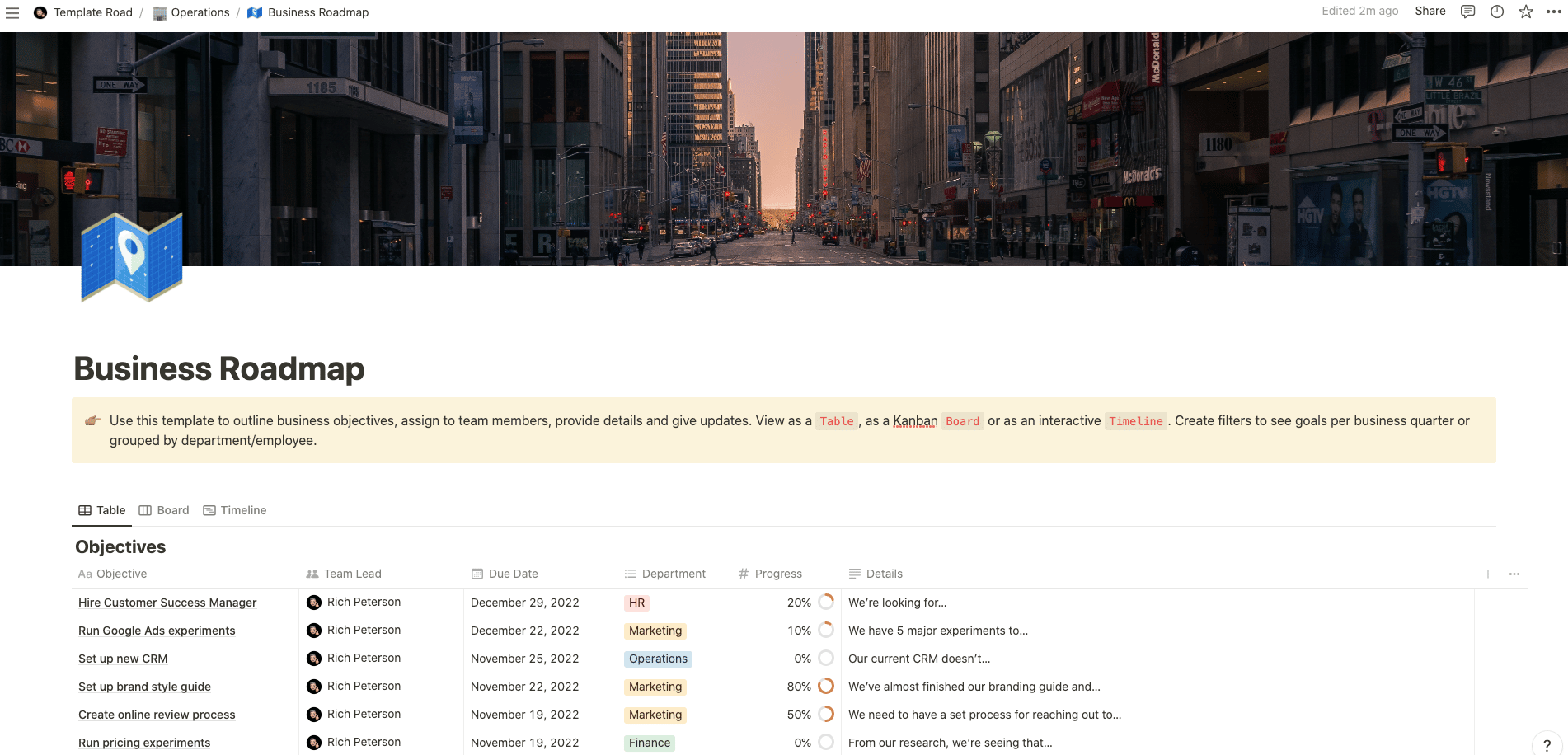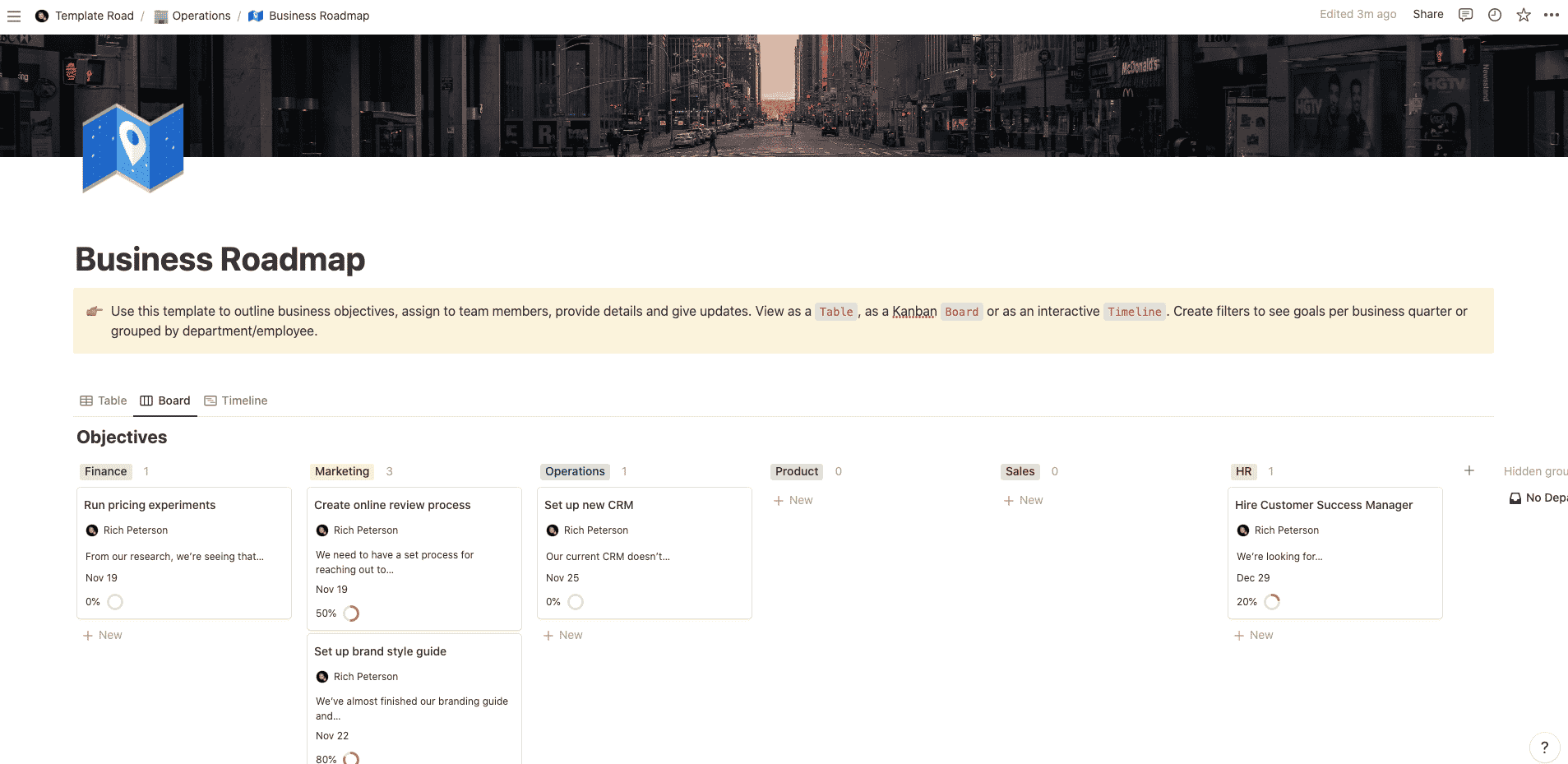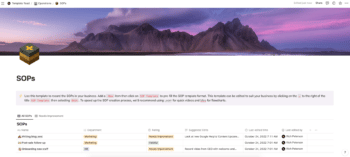Use this template to create a roadmap for your business planning.
Buy on
Contents
- Notion – Business Roadmap Template
- What is a Business Roadmap? | Definition & Overview
- Why Create a Business Roadmap?
- What is a strategic roadmap?
- How to Create a Business Roadmap
- Identify Your Goals
- Determine Who Needs to Do Which Things
- Define Stakeholders
- Set Up Milestones
- Establish Key Performance Indicators (KPIs)
- Develop Action Plans
- What should be in a business roadmap?
- Who is responsible for the product roadmap?
Notion – Business Roadmap Template
Use this template to create a roadmap for your business planning. A business roadmap is an illustration of your company s major goals and strategies. Stakeholder use business roadmaps to show initiatives and deadlines happening in various departments. Like a business plan, a business roadmap provides a long view of where the organization is going and how it’ll get there. For companies to succeed, stakeholders need to understand the big picture. Business plans knock down silos between team members and provide a clear vision for the future.
——————————————-
What you need before purchase
Basic knowledge of how to use Notion
Paid Notion account if you’re looking to add lots of content to your template / Notion account (sign up here). Not much content? You’re able to use their free account.
——————————————-
After purchase
After purchase, you’ll be able to view the template immediately. The template can be added to your Notion account by:
- Click on the template download link in Gumroad
- When viewing the Notion template, click on the “Duplicate” link in the top-right of your screen
- The template will now be available in your own Notion account
What is a Business Roadmap? | Definition & Overview
A business roadmap is an organized plan for your company’s future growth and success. It helps you identify the key areas of focus that will help you achieve your goals, as well as provide a road map for how you’ll get there. Business Roadmaps are typically created by senior management teams, but can also be used by individual employees or departments within a company. They’re often used in conjunction with annual planning processes (e.g., strategic planning) and/or performance reviews. The purpose of a business roadmap is to outline what needs to happen next in order to reach your goals. This includes identifying where you want to go, who needs to do what, when it needs to be done, and why it matters.
Why Create a Business Roadmap?
- To set clear expectations about what needs to be accomplished over the coming year(s).
- To ensure that everyone knows their role in achieving those goals.
- To make sure that all stakeholders understand the importance of reaching these goals.
What is a strategic roadmap?
Definition & Overview: Strategic roadmaps are designed to guide companies through periods of change. They help companies stay focused on their long-term vision while remaining flexible enough to respond to changing market conditions. Strategic roadmaps are usually developed by senior executives and include a detailed description of the company’s strategy, its current position, and the steps necessary to move forward.
How to Create a Business Roadmap
- Identify Your Goals
- Determine Who Needs to Do What
- Define Stakeholders
- Set Up Milestones
- Establish Key Performance Indicators
- Develop Action Plans
- Communicate Your Plan
- Evaluate Progress
- Adjust As Needed
- Celebrate Successes
Identify Your Goals
To start off, you must first clearly define your goals. These might include things like increasing sales, improving customer service, or reducing costs. Once you know exactly what you want to accomplish, you can begin developing a roadmap that outlines the steps required to get there.
Determine Who Needs to Do Which Things
Once you’ve identified your goals, you’ll need to determine which people will be responsible for accomplishing them. For example, if you want to increase sales, you’ll probably need to assign someone to handle marketing and advertising. If you want to improve customer service, you’ll likely need to assign someone to work directly with customers.
Define Stakeholders
Next, you’ll need to decide who else should be involved in creating your roadmap. Depending on the size of your organization, this could mean assigning specific roles to different groups within the company. For instance, if you have several divisions, you may want each division to develop a separate plan. Or, if you have multiple locations, you may want to assign one person to oversee operations at each location.
Set Up Milestones
Now that you’ve defined who needs to do what and how many people will be working on the project, you’ll need to establish milestones. A milestone is simply a point along the way toward your goal. It helps you keep track of progress and ensures that everyone understands what they’re supposed to be doing. You don’t necessarily need to use dates as milestones; instead, you can use events such as “by the end of the month,” “in three months’ time,” or “when we complete our new product.”
Establish Key Performance Indicators (KPIs)
Finally, you’ll need to identify key performance indicators (KPIs). KPIs are measurable metrics that indicate whether or not you’re making progress towards your goals. Some examples of KPIs include number of products sold, number of hours worked per week, and number of complaints received from customers.
Develop Action Plans
After establishing your goals, determining who needs to do what, defining your milestones, and identifying your KPIs, it’s finally time to put all of these pieces together into a single document. This process involves writing down everything you’ve learned about your company and then organizing it into a logical order.
For example, if you want your company to sell more products, you’ll need to write down the following information:
- What products do you currently offer
- How much money do you make selling those products
- The amount of profit you expect to earn by selling additional products
- Your current level of competition
- The amount of time it takes to produce each product
- Whether or not you already have plans to expand your product line
Once you’ve written down all of this information, you’ll need to organize it into a coherent document. Here are some tips for structuring your roadmap:
- Start with an introduction that explains why you created the roadmap.
- Next, list your goals.
- Then, describe your strategy for achieving those goals.
- Finally, outline the steps required to accomplish those goals.
If you follow these guidelines, you’ll be able to create a detailed roadmap that clearly outlines your company’s future direction.
What should be in a business roadmap?
A business roadmap should contain the following elements:
- An overview of the company’s overall strategy and direction.
- Detailed descriptions of each major goal, including the specific actions needed to accomplish them.
- Specific milestones along the way.
- Details regarding who needs to do what at each step.
- Key performance indicators to measure progress toward meeting the goals.
- An action plan detailing how the company plans to meet its goals.
- A timeline showing when various activities need to take place.
- A summary of any changes made during the process.
Who is responsible for the product roadmap?
The person most likely to know what your company’s long-term goals are is the CEO. However, he or she may delegate responsibility for creating the roadmap to one or more members of the executive team. If you’re unsure which member(s) should be given this task, ask yourself the following questions:
- Who has been involved in setting the company’s strategic direction over the past few years?
- Who has experience managing large projects?
- Whose expertise best matches the type of work you hope to accomplish?
- Who has access to resources such as marketing materials, financial reports, customer data, etc.?
- Who can provide input on the project’s success?
- Who will be accountable for implementing the final version of the roadmap?
- Who will be held responsible for making sure the roadmap gets implemented?
- Who is most familiar with the company’s existing processes and procedures?
- Who is most knowledgeable about the industry in which the company operates?
- Who is most comfortable delegating authority?




















